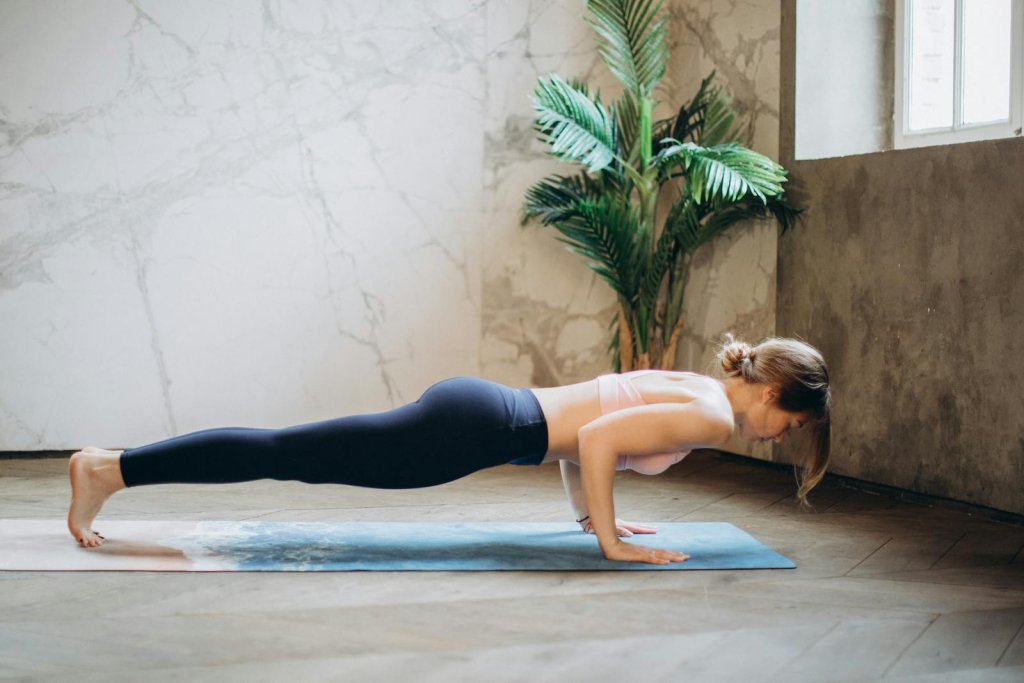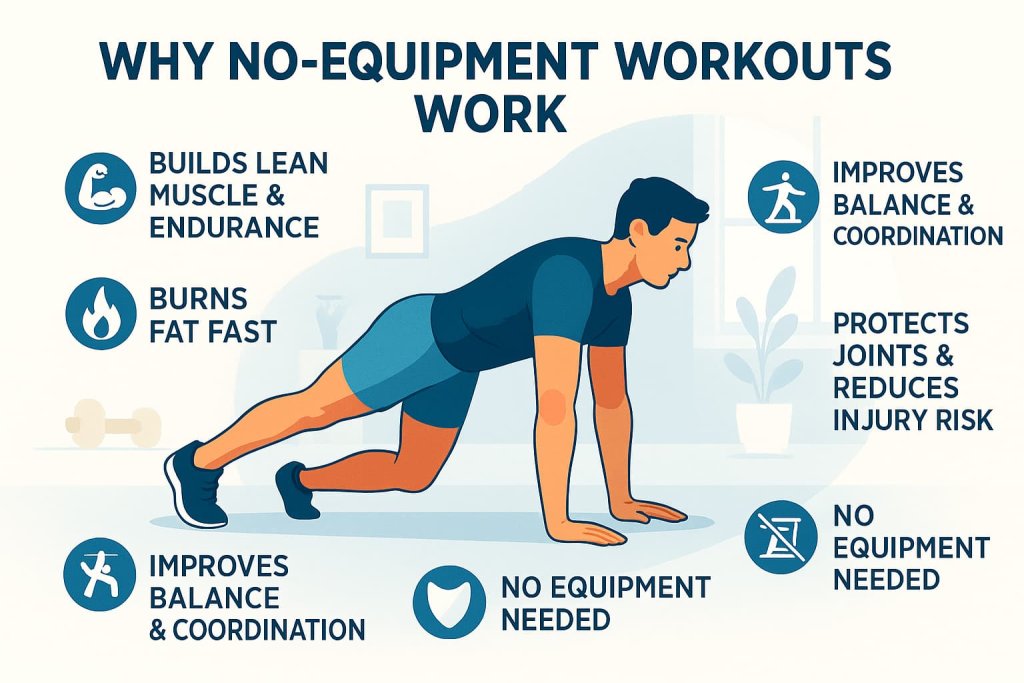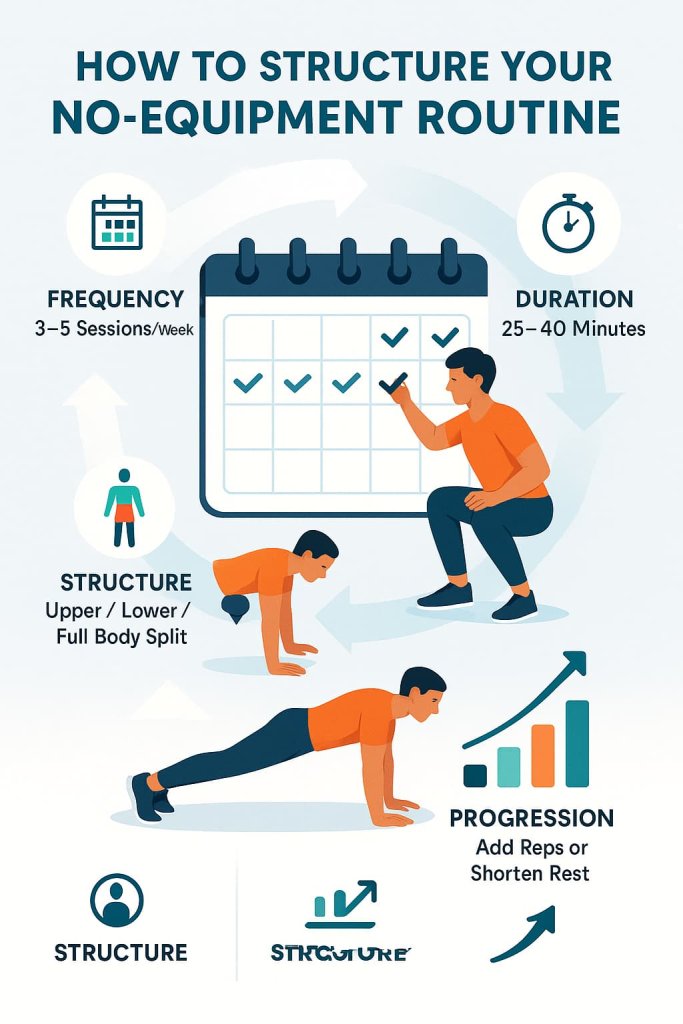Yes — you can build muscle and burn fat without any gym or equipment.
No Equipment (Bodyweight ) workouts use your own resistance to improve strength, endurance, and stability at home. Controlled trials show 8 weeks of body mass–based resistance training can increase quadriceps muscle size (hypertrophy), and simple bodyweight programs can improve cardiorespiratory fitness with minimal equipment.

Whether you’re short on time, traveling, or avoiding the gym, this guide covers the 20 best no-equipment workouts that deliver real, science-backed results.
Why No-Equipment Workouts Work
No-equipment workouts are effective because they use compound, full-body movements that activate multiple muscle groups. This boosts calorie burn, improves strength, and enhances mobility — all at once.

Benefits include:
- Builds lean muscle and endurance
- Burns fat efficiently through high-intensity circuits
- Improves balance, coordination, and flexibility
- Reduces injury risk and joint stress
- Requires zero equipment or gym membership
According to Experts, regular bodyweight training helps maintain lean mass and bone density while supporting long-term weight management.
How to Structure Your No-Equipment Routine

To get maximum results:
- Frequency: 3–5 sessions per week
- Duration: 25–40 minutes
- Structure: Alternate between upper, lower, and full-body moves
- Progression: Increase reps or reduce rest times every 2–3 weeks
Pro Tip: Combine resistance-based bodyweight exercises (push-ups, squats) with metabolic moves (burpees, mountain climbers) for faster fat loss.
20 Best No-Equipment Workouts to Build Strength and Burn Fat at Home
These 20 no-equipment workouts prove you don’t need a gym to get strong, lean, and fit. With just your bodyweight, you can build muscle, burn fat, and improve endurance anywhere.
1. Push-Ups
Why it works: Push-ups are one of the most efficient upper-body exercises, engaging multiple muscle groups simultaneously. They build functional strength by mimicking real-life pushing motions and improve core stability, balance, and endurance. When done regularly, they also help sculpt the chest and tone the arms.
Muscles worked: Pectorals (chest), triceps, anterior deltoids (shoulders), core stabilizers, and serratus anterior.
How to do it:
- Begin in a high plank with your hands placed slightly wider than shoulder-width.
- Keep your body in a straight line from head to heels, engaging your core.
- Slowly lower your chest toward the ground by bending your elbows to 90°.
- Push through your palms to return to the starting position.
Trainer Tip: Maintain tight abs and glutes to prevent your hips from dipping. For beginners, modify by performing knee push-ups or incline push-ups on a sturdy surface.
2. Bodyweight Squats
Why it works: Squats are a compound movement that strengthens your entire lower body while improving balance and joint health. They also stimulate the release of anabolic hormones, supporting overall muscle growth.
Muscles worked: Quadriceps, hamstrings, glutes, calves, and core.
How to do it:
- Stand tall with feet shoulder-width apart and toes slightly outward.
- Keep your chest up and shoulders back as you lower your hips down and back.
- Stop when thighs are parallel to the floor, then drive through your heels to return to standing.
Trainer Tip: Keep your knees aligned with your toes throughout the movement. To progress, try tempo squats — slow on the way down, explosive on the way up.
3. Lunges
Why it works: Lunges target each leg independently, correcting muscular imbalances and improving coordination. They also enhance hip flexibility and stability, which supports running, jumping, and daily movements.
Muscles worked: Quads, hamstrings, glutes, calves, and core.
How to do it:
- Stand tall, then step one leg forward into a deep lunge until both knees form 90° angles.
- Keep your front knee above your ankle and back knee hovering just above the ground.
- Push through the front heel to return to the starting position.
Trainer Tip: Keep your torso upright and shoulders stacked over hips. To increase difficulty, perform walking lunges or jumping lunges.
4. Plank
Why it works: The plank is the foundation of core training. It strengthens the entire midsection and stabilizing muscles around your spine, improving posture and preventing lower back pain.
Muscles worked: Rectus abdominis, transverse abdominis, shoulders, glutes, lower back.
How to do it:
- Lie face down and prop yourself up on your forearms and toes.
- Keep elbows under shoulders and body straight from head to heels.
- Engage your abs, glutes, and legs. Hold for 30–60 seconds.
Trainer Tip: Avoid lifting your hips too high or letting them sag. Focus on squeezing your core and glutes the entire time.
5. Mountain Climbers
Why it works: A dynamic movement that combines cardio and strength, mountain climbers increase heart rate while engaging your abs and shoulders. It’s an excellent fat-burning finisher that enhances endurance.
Muscles worked: Core, hip flexors, shoulders, triceps, quads.
How to do it:
- Begin in a high plank position.
- Drive one knee toward your chest, then quickly alternate legs in a running motion.
- Keep your shoulders above your wrists and your back flat.
Trainer Tip: Stay light on your toes and maintain steady breathing. Perform for 30–45 seconds as fast as possible without breaking form.
6. Burpees
Why it works: Burpees deliver a full-body workout that improves strength, coordination, and cardiovascular fitness. They combine a squat, push-up, and jump into one high-intensity move.
Muscles worked: Chest, shoulders, triceps, quads, glutes, hamstrings, and core.
How to do it:
- Stand tall, then squat down and place your hands on the floor.
- Jump your feet back into a plank position and perform a push-up.
- Jump your feet forward, then explode upward, reaching overhead.
Trainer Tip: Focus on a smooth rhythm rather than speed. Land softly and maintain form to avoid joint strain.
7. Jump Squats
Why it works: This plyometric exercise builds explosive power and agility while torching calories. It’s great for developing fast-twitch muscle fibers and boosting athletic performance.
Muscles worked: Quads, hamstrings, glutes, calves, core.
How to do it:
- Perform a regular squat, lowering your hips until thighs are parallel to the floor.
- Push through your heels and jump explosively.
- Land softly and descend immediately into the next rep.
Trainer Tip: Keep your movements controlled. Engage your core and avoid locking your knees upon landing.
8. Tricep Dips (Chair or Bench)
Why it works: A simple yet effective exercise for sculpting and strengthening the back of the arms. It also engages the shoulders and chest.
Muscles worked: Triceps, anterior deltoids, chest, core.
How to do it:
- Sit on a stable chair with hands gripping the edge.
- Slide your hips off the seat, keeping legs extended.
- Bend your elbows to lower yourself until arms are at 90°.
- Push through palms to return to start.
Trainer Tip: Keep elbows close to your sides. To increase intensity, elevate your feet on another chair.
9. Glute Bridges
Why it works: A great move to strengthen your glutes, relieve back pain, and improve hip stability — essential for strong squats and posture.
Muscles worked: Gluteus maximus, hamstrings, core, hip stabilizers.
How to do it:
- Lie flat with knees bent and feet hip-width apart.
- Push through your heels to lift your hips until your body forms a straight line.
- Pause at the top and squeeze your glutes.
- Lower slowly back down.
Trainer Tip: Don’t arch your lower back. Keep the motion slow and controlled for maximum activation.
10. Side Plank
Why it works: Strengthens obliques and stabilizing muscles that support balance and spinal alignment. It also challenges the shoulders and hips.
Muscles worked: Obliques, shoulders, glutes, transverse abdominis.
How to do it:
- Lie on one side with your elbow beneath your shoulder.
- Stack your legs and lift your hips to form a straight line.
- Hold for 30–45 seconds per side.
Trainer Tip: Keep your hips lifted and neck neutral. To progress, raise your top leg slightly.
11. Bicycle Crunches
Why it works: One of the most effective ab exercises, targeting both upper and lower abdominal muscles and improving rotational strength.
Muscles worked: Rectus abdominis, obliques, hip flexors.
How to do it:
- Lie on your back, hands behind your head.
- Bring knees to tabletop position.
- Alternate touching opposite elbow to knee, extending the other leg straight.
Trainer Tip: Keep your core tight and move slowly — avoid pulling your neck forward.
12. Superman Holds
Why it works: Strengthens the posterior chain — often neglected — improving posture, spinal stability, and back endurance.
Muscles worked: Erector spinae, glutes, hamstrings, deltoids.
How to do it:
- Lie face down with arms extended in front.
- Lift arms, chest, and legs off the floor simultaneously.
- Hold for 3–5 seconds, then lower with control.
Trainer Tip: Focus on squeezing your glutes and back, not just lifting higher.
13. Jumping Jacks
Why it works: A classic cardio move that boosts circulation, warms up muscles, and builds endurance.
Muscles worked: Shoulders, calves, quads, core.
How to do it:
- Stand tall with feet together and arms at sides.
- Jump feet wide as you raise arms overhead.
- Return to start and repeat.
Trainer Tip: Keep your movements light and rhythmic. Perfect for warming up or between strength sets.
14. Wall Sits
Why it works: Builds isometric leg strength and endurance while activating the core for balance. Excellent for joint stability and muscle tone.
Muscles worked: Quads, glutes, hamstrings, calves.
How to do it:
- Lean against a wall, sliding down until thighs are parallel to the floor.
- Keep knees above ankles and back flat against the wall.
- Hold for 30–60 seconds.
Trainer Tip: Focus on steady breathing and don’t rest your hands on your thighs — this reduces the challenge.
15. High Knees
Why it works: Improves cardiovascular endurance, burns calories fast, and activates hip flexors and core.
Muscles worked: Quads, calves, hip flexors, core.
How to do it:
- Stand tall and run in place, lifting your knees to hip height.
- Move arms in sync for rhythm.
Trainer Tip: Land on the balls of your feet. Maintain a quick, consistent pace for maximum burn.
16. Donkey Kicks
Why it works: Isolates and strengthens glutes and hamstrings, helping sculpt and tone the lower body.
Muscles worked: Glutes, hamstrings, core.
How to do it:
- Start on all fours.
- Lift one leg, keeping the knee bent, and kick the heel toward the ceiling.
- Lower slowly and repeat.
Trainer Tip: Keep your hips square and move under control. Add ankle weights for extra resistance.
17. Russian Twists
Why it works: Builds rotational core strength and improves overall balance and stability.
Muscles worked: Obliques, rectus abdominis, transverse abdominis.
How to do it:
- Sit with knees bent, lean back slightly, and lift your feet off the ground.
- Twist your torso side to side, touching the floor beside your hips.
Trainer Tip: Keep your chest tall and spine neutral — don’t hunch forward.
18. Bear Crawls
Why it works: Full-body movement that builds strength, stability, and coordination, especially in shoulders and core.
Muscles worked: Core, shoulders, triceps, glutes, quads.
How to do it:
- Start on hands and knees, lifting knees slightly off the ground.
- Move opposite hand and foot forward together, then switch sides.
Trainer Tip: Keep your hips low and your back flat. Move slowly for control.
19. Reverse Plank
Why it works: Strengthens the posterior chain, improves shoulder mobility, and enhances overall posture.
Muscles worked: Glutes, hamstrings, shoulders, triceps, core.
How to do it:
- Sit with legs extended and hands behind your hips, fingers facing feet.
- Push through hands and heels to lift your hips, forming a straight line.
Trainer Tip: Focus on glute engagement. Keep your head neutral and core tight.
20. Shadow Boxing
Why it works: A high-energy cardio move that improves agility, coordination, and shoulder endurance while burning calories fast.
Muscles worked: Deltoids, triceps, biceps, core, legs.
How to do it:
- Stand in a boxing stance with one foot slightly forward.
- Throw fast, controlled punches while moving your feet lightly.
- Alternate jabs, crosses, and hooks for 30–60 seconds.
Trainer Tip: Keep your core tight and punches crisp — focus on technique, not speed.
How to Progress Without Equipment
You can still apply progressive overload — the key to continued strength gains — without weights:
- Add tempo control (slower descents)
- Increase rep volume
- Reduce rest times
- Try single-limb variations
- Incorporate explosive power moves
Quick 30-Minute Full-Body Sample Routine
| Exercise | Duration | Rest |
|---|---|---|
| Jumping Jacks | 1 min | 15 sec |
| Squats | 45 sec | 15 sec |
| Push-Ups | 45 sec | 15 sec |
| Lunges | 1 min | 15 sec |
| Mountain Climbers | 45 sec | 15 sec |
| Plank | 1 min | — |
| Repeat 2–3 rounds for a complete 30-minute fat-burning session. |
Common Mistakes to Avoid
- Skipping Warm-Up: Increases risk of injury — always spend 5 minutes preparing your muscles.
- Poor Form: Rushing reps or misalignment reduces results and strains joints.
- No Progression: Repeating the same routine without increasing reps or tempo stalls progress.
- Ignoring Rest Days: Muscles grow during recovery — train 3–5 times a week, not daily.
- Neglecting Nutrition: Exercise alone won’t burn fat — maintain a balanced, protein-rich diet.
- Holding Your Breath: Breathe steadily; exhale on effort and inhale on the return.
Nutrition Tip for Faster Results
No-equipment workouts can transform your body, but nutrition is what ultimately drives fat loss and muscle definition. Even the most effective routine won’t deliver results if your diet isn’t aligned with your goals.
Focus on maintaining a moderate calorie deficit — consuming slightly fewer calories than you burn daily — to encourage steady, sustainable fat loss without sacrificing muscle. Prioritize lean proteins like eggs, chicken, fish, tofu, or lentils to support muscle repair and recovery after each session.
Aim for 1.6–2.2 grams of protein per kilogram of body weight per day, as recommended by leading sports nutrition research (Morton et al., 2018; Nunes et al., 2022). Combine this with complex carbohydrates (oats, brown rice, fruits, vegetables) for energy, and include healthy fats (nuts, olive oil, avocado) for hormone balance and recovery.
Finally, stay well-hydrated — water supports metabolism, joint health, and workout performance. A balanced diet paired with consistent bodyweight training ensures visible, lasting results.
FAQs About No-Equipment Workouts
1. Can you build muscle without weights?
Yes. Studies show that high-rep bodyweight exercises and progressive variations can effectively build muscle strength.
2. How many days per week should I train?
Aim for 3–5 sessions weekly with at least one rest day.
3. Are no-equipment workouts good for fat loss?
Yes. They raise your heart rate and increase calorie expenditure, especially when done as HIIT circuits.
4. How long should each session be?
25–40 minutes is ideal for strength and conditioning.
5. Can beginners start with these workouts?
Absolutely. Start with easier variations like knee push-ups or half squats.
6. Do I need to warm up?
Yes — always do 5 minutes of dynamic stretches and light cardio before your workout.
7. What’s the best time to train?
Any time that fits your schedule — consistency matters more than timing.
Conclusion
You don’t need a gym to get fit — just your body, determination, and a plan.
These 20 no-equipment workouts are proof that you can build strength, endurance, and burn fat anywhere.
Start today — set a timer, clear your space, and take the first step toward your best shape yet.
References
- ACSM – Physical Activity Guidelines (Strength 2+ days/week)
Supports training frequency and safe, evidence-based recommendations. - ACSM – Physical Activity Guidelines: FAQs
Plain-language guidance reinforcing 2+ days/week muscle-strengthening. - Kikuchi & Nakazato (2017) – Push-ups vs Bench Press (8-week trial)
Shows bodyweight push-ups can match low-load bench press for strength/hypertrophy—great support for no-equipment strength claims. - Archila et al. (2021) – Simple Bodyweight Training Improves Cardiorespiratory Fitness
Backs your cardio/fitness benefits from short, equipment-free sessions. - Ogawa et al. (2023) – Free Weights vs Body Mass–Based Resistance Training (8 weeks)
Evidence that body mass–based programs can increase muscle size; relevant to your “build strength at home” message. - Nunes et al. (2022) – Protein Intake & Lean Mass: Systematic Review/Meta-analysis
Confirms higher protein supports lean mass with resistance exercise. - BJSM – FIFA 11+ Overview (Injury-prevention warm-ups)
Authoritative evidence that structured warm-ups reduce injury risk—perfect for your “Common Mistakes: don’t skip warm-up.”
